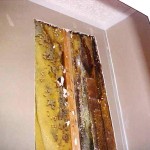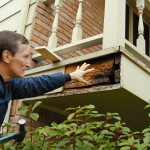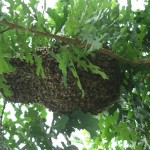While honey bees are beneficial- producing honey, wax and pollinating crops- there are certain situations that may require extermination of bees (colony location, hypersensitvity, etc.). Aggressiveness may be related to the type of bee (European or Africanized), whether it’s a swarm or a colony, or conditions of the environment (i.e. vibrations) In any case, all bees are capable of stinging and care should be taken when they are around.
Swarms: Bee swarms consist of a group of bees clustered together. The cluster often rests on items such as tree limbs, fences, mailboxes, or bushes. A swarm may stay in the same location for a few hours to several weeks. Swarms are produced as a part of the colony’s reproductive process. An established colony produces a new queen, causing the old queen and about half the worker bees to leave the colony and search for a new nest location. Scout bees are sent out from the swarm to search the area for a nesting site. Swarming honey bees are usually gentle and unlikely to sting.
Colonies: Bee colonies are established by swarming bees. After selecting an appropriate site, the bees begin to build comb out of wax to store food (honey and pollen) and rear young. After about four weeks, the bees become defensive of the nest and are more likely to sting when disturbed. Colonies may be found in wall voids, chimneys, attics, sheds, treeholes and other areas. When bees are nesting in a wall void, DO NOT block their entrance; they will search for another way to exit and may move into the structure. To keep bees from entering a home, seal any holes found in walls where pipes enter the home- cracks in window framing, knotholes, weep holes, or cracks between wood and brick junctures.
 If a person has a bee SWARM, tell them the bees should move on within a few hours to a few weeks. Also explain that if left alone, swarms are typically docile and unlikely to sting. If a COLONY is in a sensitive location or if a person is allergic to bee venom, tell them to contact a pest control professional or beekeeper to get rid of the bees. Once bees are removed, it is best to remove wax and honey to avoid secondary invaders such as rodents and wax moths.
If a person has a bee SWARM, tell them the bees should move on within a few hours to a few weeks. Also explain that if left alone, swarms are typically docile and unlikely to sting. If a COLONY is in a sensitive location or if a person is allergic to bee venom, tell them to contact a pest control professional or beekeeper to get rid of the bees. Once bees are removed, it is best to remove wax and honey to avoid secondary invaders such as rodents and wax moths.
Africanized bees: Africanized bees have been found in over 50% of the counties in Texas. These bees are slightly smaller than European honeybees, but they look very similar and require lab analysis to tell them apart. Africanized honey bees tend to be more defensive if provoked.
I do NOT recommend that anyone takes on a bee job themselves. Pest control companies have equipment, such as bee suits to protect against being stung, to carry out these jobs in a safe manner.
It must bee spring
By Mike Merchant (From his Insects in the City Blog)
A honey bee swarm on a park bench demonstrates that bees will make use of any available resting spot.
Despite a winter that just won’t seem to let go, spring is definitely here. I know this because the honey bees are swarming, and local callers are reaching out to Extension offices for help coping with the sudden bee invasion.
According to Shelly Spearman of the Rockwall County Extension office, her office is getting one to two calls a day about bees. “We’re getting a lot of calls about bees hanging out in trees,” she said.
So why are bee mobs suddenly invading our trees and landscapes? And what do we need to do to protect ourselves and our loved ones?
The first thing to know is that this is prime bee swarming season. Bee “mobs” (actually swarms) are the bees’ way of coping with rapid colony growth in the spring following the return of flowers and their abundant supply of pollen and nectar. As the colony begins to grow and crowd the nest, worker bees begin producing a new queen and drones (male bees). Just before the new queen emerges, the old queen takes a portion of the colony and leaves her hive in search of a new home.
In flight, a bee swarm resembles a tornado of bees. The departure of the queen from the old colony is the trigger for the swarm, and the worker bees generally follow the queen wherever she goes. In the course of this bee exodus, the queen and her colony occasionally stop to rest. Resting sites may include just about anything from a tree branch to a car, a park bench to backyard play equipment.
So what’s the risk should a bee swarm land in your yard or place of work? In most cases, it’s very low. Most bee swarms are not aggressive and will tolerate lots of human activity nearby. But there are exceptions, so it’s best to keep children and anyone with a known allergies to bee venom a safe distance away. Swarms generally don’t stay very long either. If the swarm has just emerged from a nearby hive, it usually takes off within a matter of hours. In most cases, a bee swarm will move on within a day or two and you’ll never see it again. On the other hand, if one of the colony’s scout bees discovers a good nest site nearby, the swarm could become a long-term neighbor or take up more or less permanent residence in your home. For this reason, many people choose to call a pest control company or beekeeper to kill or collect bee swarms that settle near their house.
 While bee swarms are generally harmless, bee colonies that get into the home can become an expensive problem. Now is an excellent time to check your home for holes and gaps that need filling, BEFORE the bees move in.
While bee swarms are generally harmless, bee colonies that get into the home can become an expensive problem. Now is an excellent time to check your home for holes and gaps that need filling, BEFORE the bees move in.
Most of us would prefer to move rather than kill a bee swarm. The majority of folks who call my office want to “give” the colony to a local beekeeper. But many beekeepers are increasingly wary of the genetics and potential diseases or mites associated with feral bee colonies. And it’s increasingly rare to find beekeepers, especially in urban areas, who will remove bees at no charge.
In Texas, registered beekeepers who do not use pesticides can legally remove honey bee swarms and charge you for the service. However, if pesticides are used, the beekeeper must have a pest control license and work for a licensed and insured pest control business to charge you for bee control. If you live in a different state, check with your state Apiary Inspection Service or your county Extension office to find out what your local rules say.
It may seem ironic to talk about killing a bee colony, given our society’s appreciation for bees, and all the recent press concern about the decline of honey bees. But wild bees are in no way endangered and, despite the stories you might hear, it is legal to kill a bee colony or swarm that is in an undesirable location.
In general, it’s rarely necessary to kill a bee swarm that is outdoors, in the open. Swarms, depending where they land, are relatively easy to collect alive. But once they get into a structure or home, they become much more difficult (and expensive) to extract peacefully.
Of course the best solution to bees is prevention. Now is the time to check your home for holes and gaps, especially under the edges of wood siding, and around windows, roof lines and soffits. These are the kinds of places that bees love. Expanding foam, silicone sealant or other methods should be used to seal all voids and holes. If you discover bees already in your home, look for a pest control company or beekeeper business that performs bee removals.
We’ve waited this long for spring, we should be enjoying it and not worrying about bees. For more information about bee control in homes, see our Honey Bees in Homes factsheet. To look for a local beekeeper who might be willing to collect a bee swarm, search for your closest beekeeping chapter at the Texas Beekeepers Association website .



 .
.